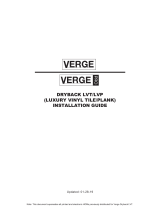
Epoxy Requirements
Standard Set Epoxy Adhesive:
A properly mixed epoxy adhesive should display
the following characteristics of the combined
components:
Gel Time: 7 to 13 minutes
Bond Strength to Concrete
Time to reach not less than 200 psi at 77ºF
(14 kgs/cm
2
at 25ºC)
180 minutes (3 hours)
Shear Strength
24 hrs. @ 77ºF (25ºC) 2200 psi (154 kgs/cm
2
)
24 hrs. @ 77ºF (25ºC) plus water soak
1500 psi (105 kgs/cm
2
)
Sufficient pressure and adhesive must be used to
assure a visible bead of adhesive around the
perimeter of the marker. Excessive epoxy in front
of the reflector surface should be scraped aside.
Follow the manufacturer’s recommendations for
application.
Recommended Epoxy Adhesive
E-Bond Epoxies, Inc.
501 NE 33rd Street
Ft. Lauderdale, FL 33307
(954) 566-6555
Part# 1240/1241 Epoxy Adhesive
Fast Set Epoxy Adhesives: Series 290 raised
pavement markers are also compatible with fast-
set epoxy systems. Follow the manufacturer’s
recommendations for application.
Bitumen Adhesive Requirements
Bitumen adhesive is a homogeneous mixture of
asphalt binder and mineral filler. It is a single-part
system designed to be melted, then applied by
pouring or pumping. Bitumen adhesive sets up on
cooling and is ready for traffic within five
minutes. Follow the manufacturer’s
recommendations for application. For Series 290
markers typical adhesive usage is one pound per
three markers applied.
Recommended Bitumen Adhesive
Crafco, Inc.
420 Roosevelt Avenue
Chandler, AZ 85226
(800) 528-8242
Part # 34269 Bitumen Adhesive
Other Adhesives:
Application of Series 290 markers is only
recommended with the use of adhesives meeting
the requirements listed in this information folder.
It is expected that other epoxy or bitumen
adhesives will be suitable but markers should be
tested with these adhesives to determine suitability
before using.
Health and Safety Information
Read all health hazard, precautionary and first-aid
statements found in the Material Safety Data
Literature Reference:
PB 290 3M™ Raised Pavement Marker 290
Sheet (MSDS) and/or product label of chemicals
prior to handling or use. Also refer to the MSDS
for information about the volatile organic
compound (VOC) content of chemical products.
Consult local regulations and authorities for
possible restrictions on product VOC content
and/or VOC emission.
For further information, contact: 3M Traffic
Safety Systems Division, 1-800-553-1380. Follow
instructions to reach Technical Service for
Pavement Markings. In Canada call 1-519-452-
6201.
Visit us on the Internet at www.3M.com/tss
3M assumes no responsibility for any injury, loss or damage arising out of the use of a product that is not of our manufacture. Where reference
is made in literature to a commercially available product, made by another manufacturer, it shall be the user’s responsibility to ascertain the
precautionary measures for its use outlined by the manufacturer.
Important Notice
All statements, technical information and recommendations contained herein are based on tests we believe to be reliable, but the accuracy or
completeness thereof is not guaranteed, and the following is made in lieu of all warranties, or conditions express or implied. Seller’s and
manufacturer’s only obligation shall be to replace such quantity of the product proved to be defective. Neither seller nor manufacturer shall be
liable f
or any injury, loss or damage, direct, special or consequential, arising out of the use of or the inability to use the product. Before using,
user shall determine the suitability of the product for his/her intended use, and user assumes all risk and liability whatsoever in connection
therewith. Statements or recommendations not contained herein shall have no force or effect unless in an agreement signed by officers of seller
and manufactur
er.
3M is a trademark of 3M. Used under license in Canada.
Traffic Safety Systems Division 3M Canada Company 3M México, S.A. de C.V.
3M Center, Building 0235-03-A-09 P.O. Box 5757 Av. Santa Fe No. 55 Please recycle.
St. Paul, MN 55144-1000 London, Ontario N6A 4T1 Col. Santa Fe, Del. Alvaro Obregón © 3M 2010. All rights reserved.
1-800-553-1380 1-800-3MHELPS México, D.F. 01210 Bolger 10080280
www.3M.com/tss Electronic Only








